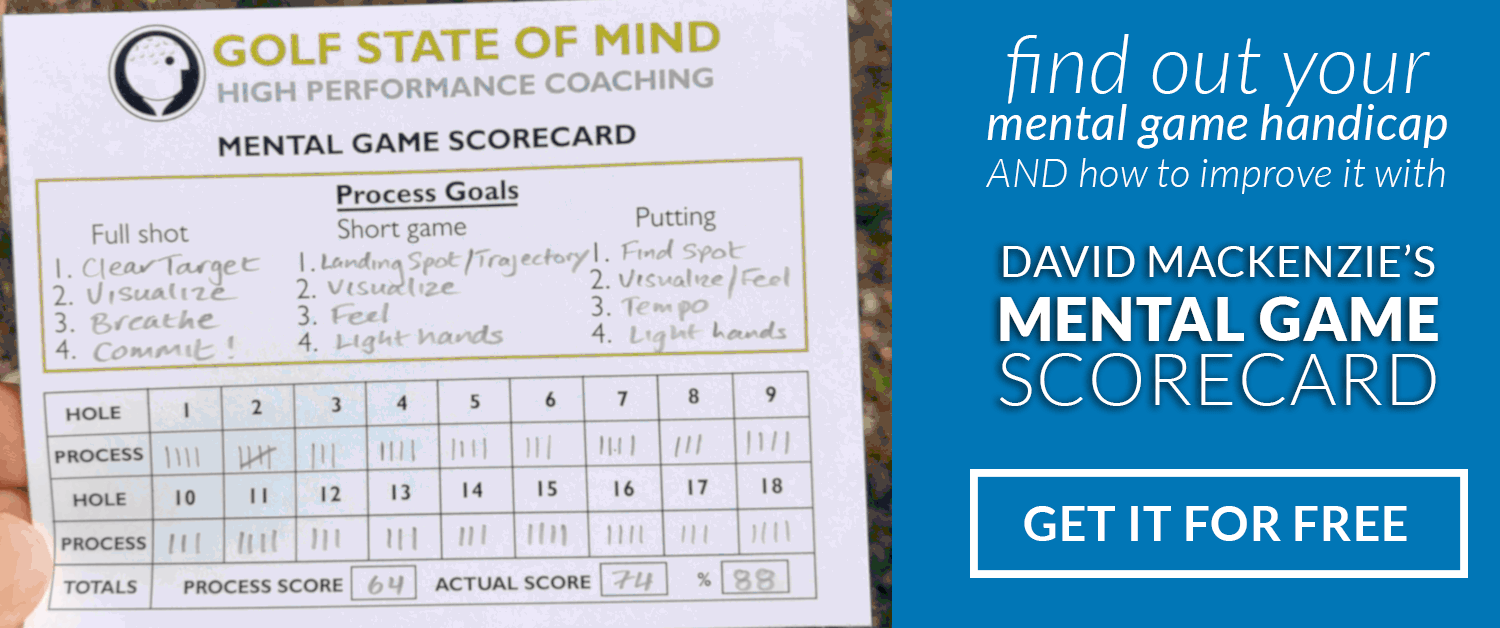
5 Ways To Play More Golf In The Zone
Playing Golf In The Zone
Whenever I ask players to describe their mental state during their best rounds, they all say very similar things, such as:
- Feeling confident
- Not having expectations or worries about score
- A sense of freedom
- Being in the present moment
- Being alert and focused, with no distractions
- Not thinking about or trying to control swing mechanics, instead having full trust in their skills
- Relaxed and calm, yet highly focused
- A sense of optimism and fulfillment
- Being emotionally balanced
The state of mind that these players are describing is synonymous with “the zone” or “Flow State”, which I’m sure you’ve experienced at least once. Ironically, it happens when you least expect it to.
But what usually follows this description is the question: “How can I feel like that more often?” Most of us just accept that this optimal state of mind for golf is something that only happens at random and we can’t do much about when it shows up.
Although we can’t “try” to get into the zone, we can train ourselves on and off the course so that golf in the zone can be accessed more readily and more frequently. In this article I’ll give you 5 simple ways to do it.
“Flow is when we act freely, for the sake of the action itself rather than ulterior motives, that we learn to become more than we were.” – Mihaly Csikszentmihalyi
1. Be Immersed in Your Process (Clear Goals)
All of my students measure the success of each shot (and their rounds) by the quality of their process, not the outcome. We determine what the individual player needs to focus on before, during and after every shot to have them feeling confident, engaged and athletic. Process goals tell us where we need to place our attention and with practice, we make them a habit. There’s less thinking required as you already know what you are going to do, and focus on. This will get you more immersed in the “activity” as opposed to the outcome (“ulterior motives”) or consequence of the shot. Trust in a good process will keep the conscious mind quiet over the ball and allow the swing to be more subconscious (“we act freely”), resulting in a better execution.
2. Be Present
One of those things that players describe when playing golf in the zone is being very “present”. This means they’re not preoccupied with what just happened or what might happen next, the mind is quiet and in THE NOW. You’re not thinking, you’re just being. Learning how to be more present or more “mindful” is a skill, that you can get better at it with practice. You can practice it off the course too, during any activity, by being more mindful of where your attention is. If you notice yourself getting distracted by thoughts, just bring yourself back to the activity and the sensations of it. Overtime, you’ll notice that your focus will improve and you’ll be able to go longer without being distracted.
3. Embrace Pressure
Ask any elite player whether they would rather be slightly nervous or completely relaxed before and during a round and they will probably tell you “slightly nervous”, the reason being is that they are more likely to access Flow and play better. When we are playing with high stakes with an uncertain outcome, it activates the nervous system. Research by Steven Kotler of Flow Research Collective suggests that a person needs to reach a certain level of stress (or “arousal”) to trigger Flow.
You will know this as pre-round nerves or first tee jitters which you probably think of as being a sign that you won’t play well. But in fact it can be a performance enhancer, provided you can keep your mind in the present. Along with that increased heart rate and feeling of butterflies, comes increased focus and higher sensory awareness that can elevate your performance – we become more mentally and physically alert.
Remember this next time you feel nervous before a tournament. Choose to embrace being out of your comfort zone as it can actually raise your game by inducing Flow.
4. Challenge Yourself
Steven Kotler also tells us that the sweet spot for activating Flow is for the challenge to be slightly higher (he says 4%) than your current skill level. In other words, the challenge is just hard enough to get your attention and get you fully engaged in the task. Have you ever wondered how you can play great shots out of trouble, whereas you can miss an easy approach shot into a big green? This is an example of how challenge can induce focus and flow. On the more difficult shots you are more challenged and focused. The key to inducing flow is to create that challenge and higher level of engagement and focus before every shot.
5. Lose the ego! (The “Self” must disappear)
Self-consciousness interferes with the Flow State. When players describe playing golf in the zone, there’s no worrying about how they look to others, they’re immersed in what they are doing. In Flow, there is no sense of “self”.
Ego golf means you are too wrapped up with the outcome and how your play makes you look, instead of being immersed in the activity (the process). That desire for good outcomes and avoidance of bad outcome creates too much pressure on every shot – there’s too much thinking and worry for there to be Flow.
When I notice this in a new student, I immediately begin working with them on their awareness of this type of thinking and help them become a mastery golfer, and they dissolve their ego.
Thanks for reading. Practice these 5 steps and I’m confident you’ll experience golf in the zone more often.
Want to train yourself in the process to develop your mental skills for golf? Then download my mental game scorecard below.



Pingback: Eliminating Your Slice Through Mental Preparation
Hey Jesus, although a little too technical for me, I appreciate the contribution. I go for a purely visualization and feel approach to golf teaching and learning how to optimize the mind for improving performance.